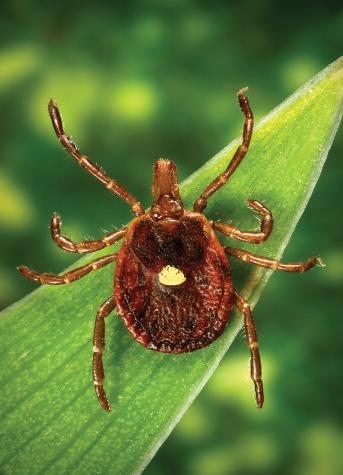COLUMBIA, Mo. – Missouri ticks are worse than a Transylvanian vampire on Halloween. Many people think ticks are most active during summer. However, fall is prime time for ticks. Deer are primary hosts for ticks, and fall is when deer move due to mating season and to find vegetation to build fat reserves for winter, says Emily Althoff, University of Missouri Extension and Lincoln University urban entomologist.
Ticks are especially concerning now due to increased incidences of alpha-gal syndrome, which can cause a variety of symptoms, including an allergy to red meat. Ticks also transmit other diseases such as Lyme disease, Rocky Mountain spotted fever, encephalitis and anaplasmosis.
Ticks use their barbed mouthparts to cut through the skin of humans and animals like a saw. They insert a small feeding tube into the skin to feed. You can’t flick a tick because it hooks itself into the skin when it bites. Revenge is difficult: their tough “skin,” or exoskeleton, makes them hard to crush. Once engorged with blood, they can swell from the size of a sesame seed to about 3/8 inches long.
Like any good Halloween gobblin’ goblin, ticks sneak up on humans when they least suspect it. They do so by “questing,” a term describing how they climb to the top of a grass stem or branch and lie in wait for a host to pass. Ticks use their sense of smell and ability to detect vibrations to alert them that food is on its way.
Missouri Department of Conservation lists three common ticks in Missouri:
- Lone star tick, which causes Alpha-Gal Syndrome, tularemia and other diseases. Females are easily identified by the white dot in the center of the back. Males often have dots or white streaks on the edge of their bodies.
- American dog tick. Adults have an ornate brown-and-white mottling on the dorsal side. Blood-engorged females are gray.
- Deer tick. Legs and upper body are black.
Althoff gives these tick tips to prevent tick bites:
- Use tick repellent. Repellents such as DEET, picaridin and oil of lemon eucalyptus are considered effective.
- Dress to protect. Wear long-sleeve shirts and long pants before entering wooded or grassy areas. Tuck your shirt into your pants.
- Fight the bite. Walk in the center of trails to limit exposure. Avoid areas with tall grass and leaf litter.
- Inspect. Check yourself and pets for ticks after leaving wooded areas. Immediately wash clothing in hot water. Dry on the high setting. Shower immediately.
If you find a tick attached to your skin, remove it carefully:
- Use tweezers to grab the tick as close to the skin’s surface as possible.
- Pull straight up when removing the tick. Do not twist or jerk.
- Never crush a tick with your fingers.
- After removing, clean the area with rubbing alcohol or soap and water.
Follow up with your doctor if you develop a fever or rash within several weeks of removing a tick.
Learn more
Related MU Extension publications available for free download
- Ticks. Brief overview of common tick species in Missouri, tick-borne diseases and prevention and treatment of tick bites.
- Ticks and Tick-Borne Diseases. A more detailed guide from MU’s Integrated Pest Management program.
Photo
Lone star tick
The lone star tick, one of the most common tick species in Missouri, can spread Heartland disease, first found in Missouri in 2009. Female lone star ticks can be identified by the white dot in the center of the back. Photo courtesy U.S. Centers for Disease Control and Prevention.

